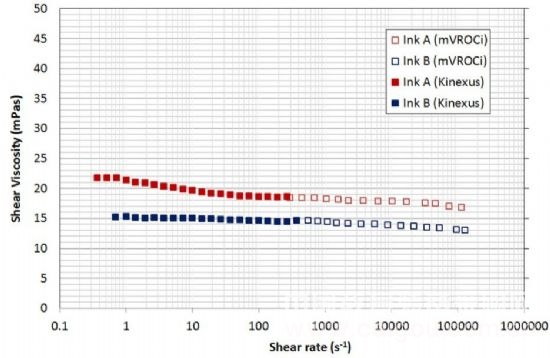Characterizing the Printing Performance of Low Viscosity Ceramic Inks Using a Microfluidic Rheometer
Author: John Duffy, Rheological Product Marketing Manager at British Malvern Instruments Ltd
This article was originally published in the August 2014 issue of Polymer Coating Pigments.
In recent years, inkjet printing has become one of the most efficient methods for tile decoration, enabling high-definition patterns and images to be printed on various non-planar ceramic surfaces. To achieve these results, ceramic inks must be formulated with specific rheological properties that suit the demands of the inkjet printing process. This means the ink should remain stable under gravity during storage and exhibit the right flow behavior when subjected to intense shear forces inside the print head. Traditional rotational rheometers are widely used to measure shear viscosity across a range of shear rates. However, they are not ideal for simulating the ultra-high shear conditions found in inkjet printheads, which can reach up to 10âµ to 10ⶠsâ»Â¹. A newer technique—microfluidic rheology—offers significant advantages in this area, making it an essential tool for developing advanced ceramic inks. The importance of rheological data in the printing process cannot be overstated. For effective jet actuation and droplet deposition, ceramic inks need to have a low viscosity, ideally between 5 and 25 mPa·s. Yet, low viscosity can compromise the ink’s stability during storage. This creates a challenge: the ink must maintain sufficient viscosity under low shear conditions (like gravity) to prevent sedimentation, but also reduce its viscosity significantly under high shear to ensure smooth ejection from the nozzle. Ceramic inks typically consist of solvents, binders, surfactants, and suspended pigments or dyes. These components are prone to settling if the ink is too fluid. Therefore, achieving the right balance between storage stability and print performance requires precise control over the ink’s viscosity across a wide range of shear rates. Microfluidic rheometry offers a solution. By passing the ink through narrow microchannels (typically 40–200 μm), the technique measures pressure drops using embedded MEMS sensors, allowing for accurate viscosity measurements even at extremely high shear rates. Unlike traditional rotational rheometers, microfluidic devices can handle these extreme conditions without issues like flow instability or shear heating. In our experiments, we combined the Malvern Kinexus rotational rheometer with the m-VROCi microfluidic rheometer to analyze two commercially available inkjet inks. The results showed that both inks exhibited slight shear-thinning behavior, with their viscosities decreasing slightly at higher shear rates. Ink A had a viscosity of around 22 mPa·s at 1 sâ»Â¹ and dropped to about 17 mPa·s at 100,000 sâ»Â¹. Although the change wasn’t dramatic, it highlights the importance of understanding non-Newtonian behavior in optimizing ink performance. Looking ahead, as inkjet printing becomes more widespread in the ceramics industry, there's a growing need for inks that perform reliably across all stages of application. Microfluidic rheology provides critical insights into how inks behave under real-world printing conditions, helping researchers develop formulations that are stable, easy to print, and deliver high-quality results. By combining microfluidic and rotational rheology, scientists can simulate the full range of shear conditions that inks encounter during printing, ensuring optimal performance from formulation to final product. This approach not only improves print quality but also enhances the overall reliability and efficiency of ceramic inkjet systems.End
Figure

Figure 1: Flow curves obtained using a rotary rheometer (solid squares) and a microfluidic rheometer (open squares) show the viscosity of the ink over an extremely wide shear rate range (0.5 sâ»Â¹ to 100,000 sâ»Â¹).

Figure 2: The Malvern Instruments m-VROCi microfluidic rheometer is capable of measuring the viscosity of inks at very high shear rates.
Silver Mirror,Round Silver Mirror,Silver Standing Mirror,Mini Transparent Silver Mirror
Dongguan Huahui Glass Manufacturing Co.,Ltd , https://www.antiquemirrorsupplier.com